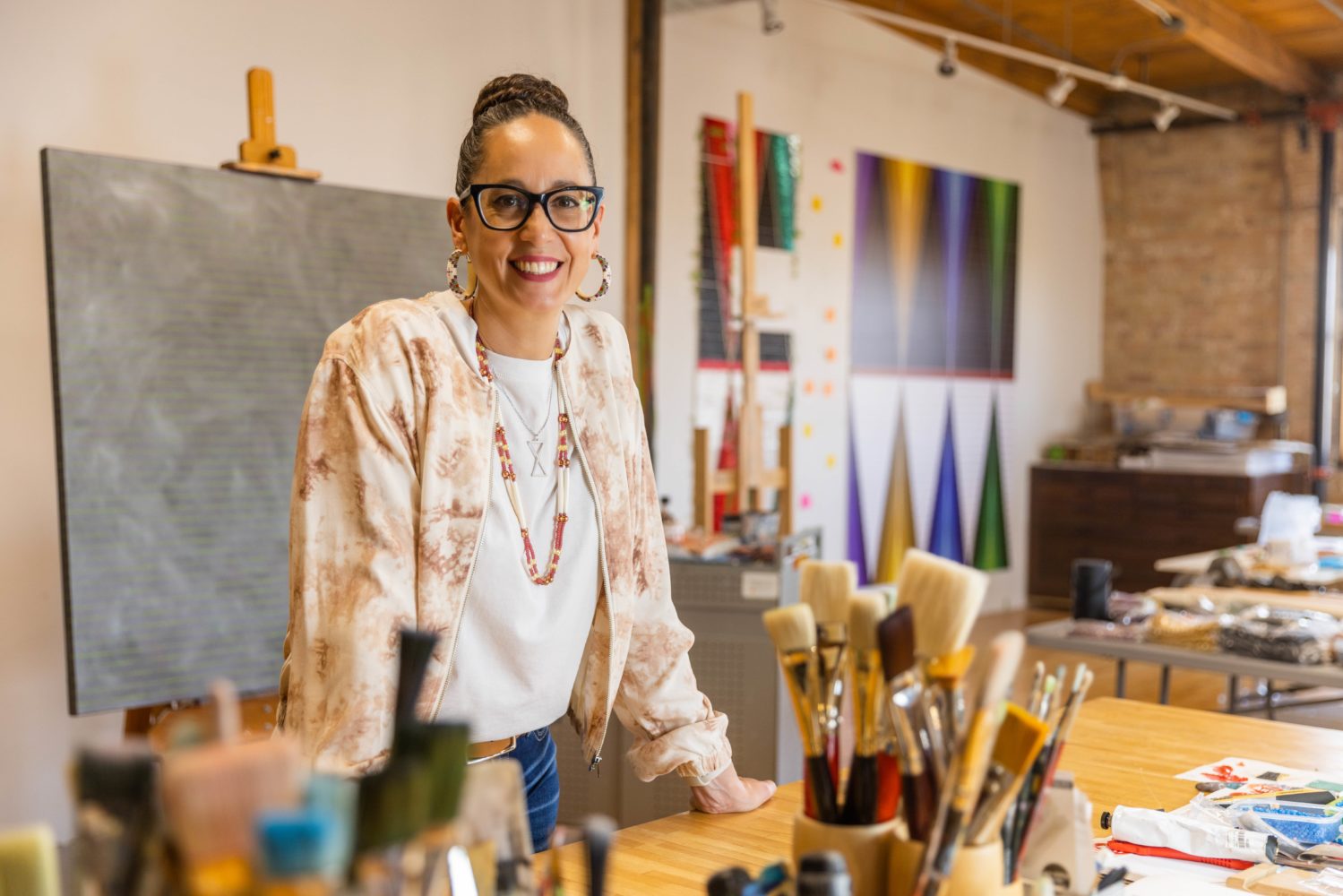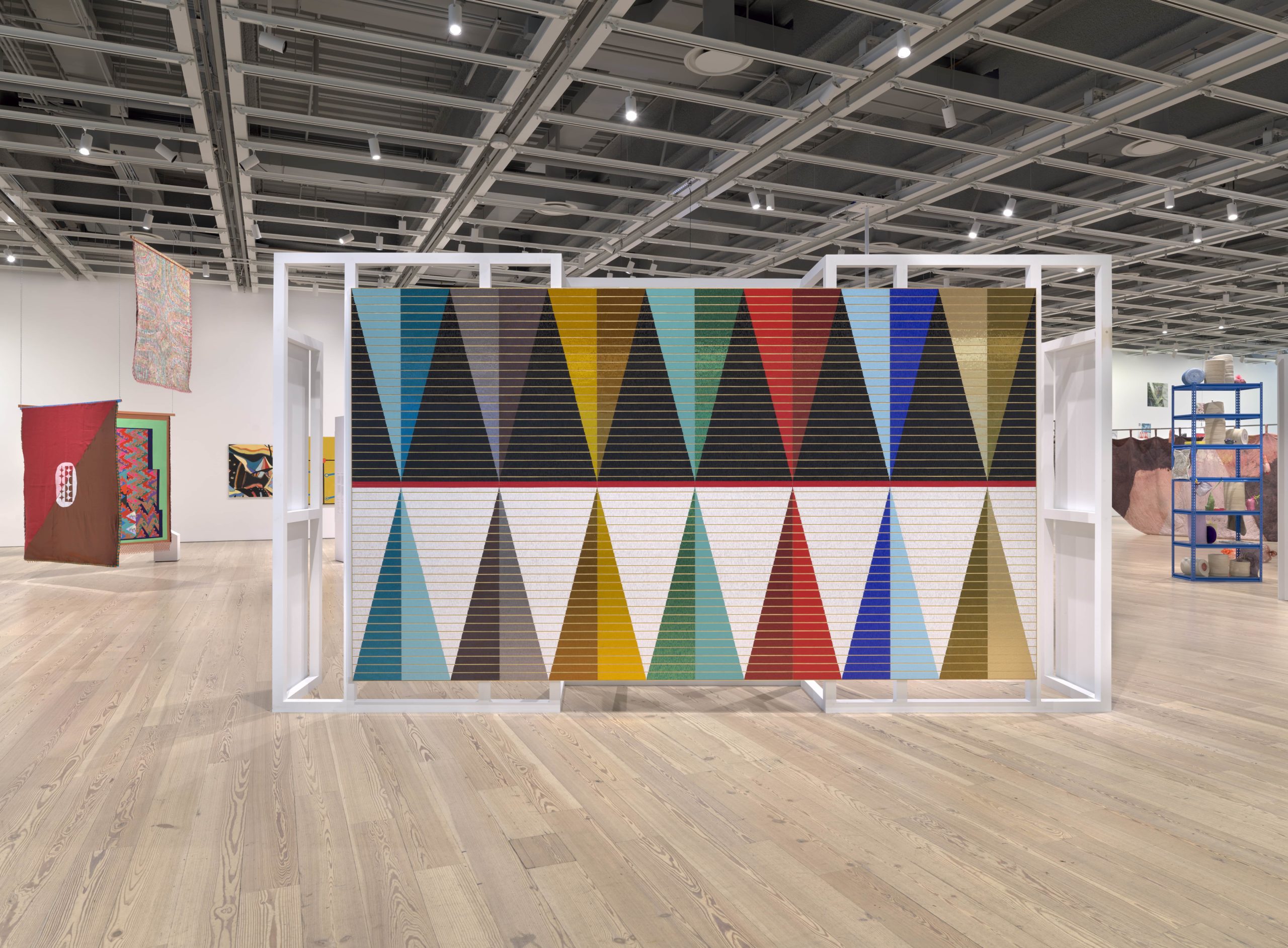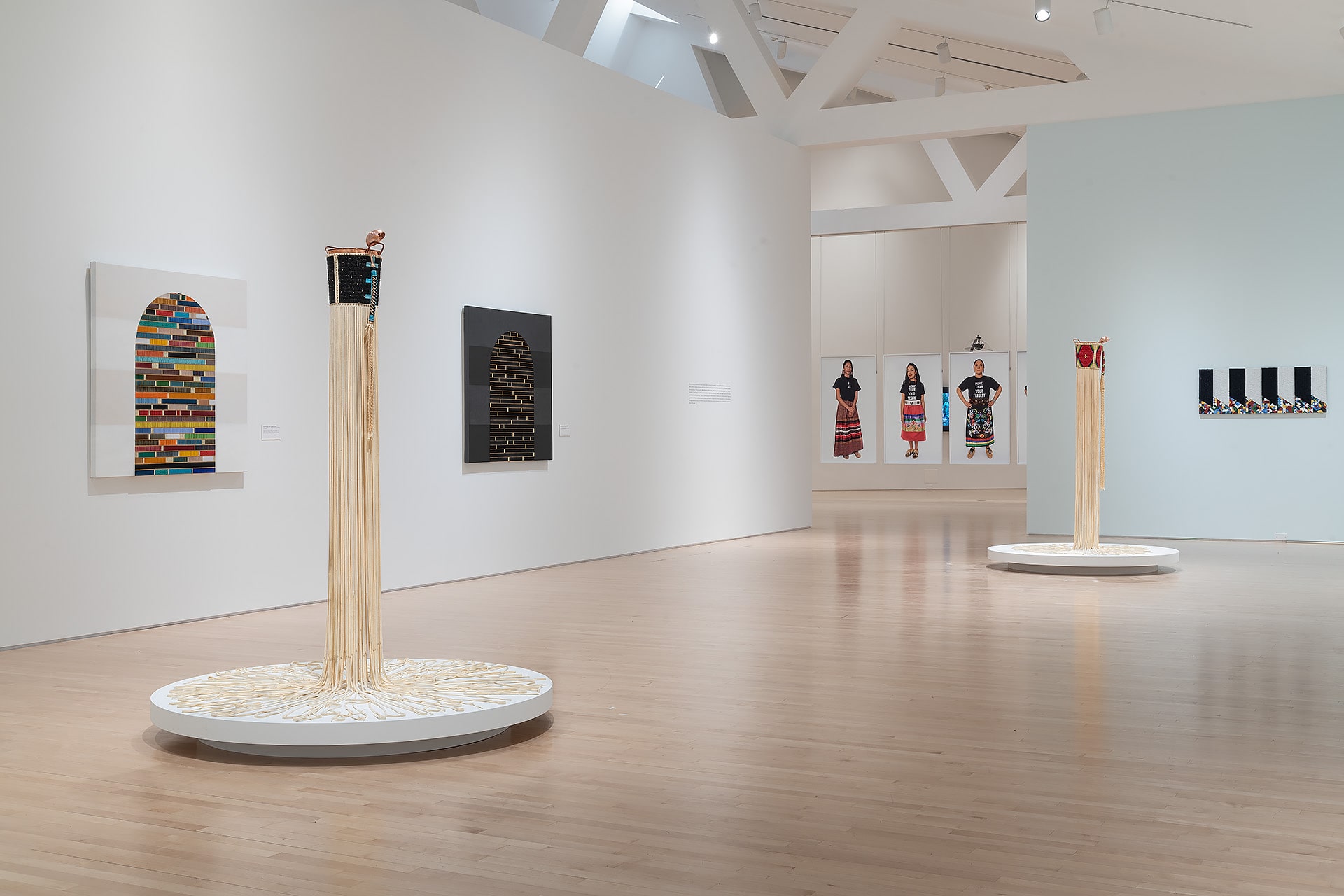Dyani White Hawk is a Minneapolis-based visual artist whose studio practice is rooted in painting and beadwork, as well as installation, video, and photography. As a woman of Sičangu Lakota and European-American ancestry, she pulls from a complex personal and national history to create honest works that speak to the Indigenous experience in the U.S. In the studio, she combines a love of painting with the rich tradition of Lakota art forms like beadwork, porcupine quillwork, and painted parfleche.
Her solo show last spring at the Museum of Contemporary Art Denver, “Speaking to Relatives,” coincided with her inclusion in the Whitney Biennial in New York. There, anchoring the fifth-floor entrance, was White Hawk’s dazzling eight-by-fourteen-foot Wopila | Lineage (2021), made from loomed glass bugle beads on aluminum panels, woven into a pattern of interlocking triangles in vibrant colors. This work and others—like her “Carry” series, featuring copper vessels covered in buckskin, glass beads, and brass sequins—challenge Eurocentric ideas around the origins of abstraction, while recognizing communal support, the influence of a lineage that is still ongoing.
Ahead of debuting her newly commissioned work at the Pennsylvania Academy of the Fine Art’s “Rising Sun” exhibition, opening in March 2023, White Hawk shared with Whitewall why her work is not about the conservation of Indigenous art, but rather the continuation of it.

Portrait of Dyani White Hawk by Jaida Grey Eagle.
WHITEWALL: You mentioned you were “raised with Native and urban American communities.” How did your upbringing impact your practice and view of the art world?
DYANI WHITE HAWK: Part of our family story is rooted in the effects of removal and generations of systematic efforts to assimilate Native people. In this way the history of tribal–federal government relations has had very direct effects on our family, which through life experiences, are inevitably reflected in my work. My mother was born on the Rosebud Sioux reservation in South Dakota. She was adopted by a non-Native couple at 18 months and relocated to Wisconsin, which is where she met my father. My father’s family is German and Welsh American. His family settled in Wisconsin. I was born and raised in Madison, Wisconsin.
Shortly after my parents divorced, my mother returned to Rosebud and was reunited with our family in the late eighties. I grew up the first decade of my life knowing I was “Indian,” but not having much context beyond the label. After being reconnected with our family, we traveled back and forth to South Dakota as often as possible. My mother worked hard to make sure I didn’t suffer the same kind of disconnect from family, culture, and identity that she had endured.
After my parents divorced, my mom found much of her closest friends and support among the Native community in Madison, Wisconsin. So a significant portion of my most formative teen and young adult years were spent among a tight-knit, intertribal, urban Native community.
Simultaneously, I was a young teen, being raised in an American city. I went to public school, fell in love with skateboarding, snowboarding, hip-hop and house music, and spent a lot of time going to concerts and immersed in the local rave scene. At 24, I decided I was ready to go to college full-time. I left Madison and headed to Lawrence, Kansas, to attend Haskell Indian Nations University, a four-year tribal college that had originally served as boarding school. I met my husband, Daniel Polk, and we had our first daughter, Nina, while attending Haskell.
In 2005, we left for Santa Fe, New Mexico, so that I could pursue my BFA at the Institute of American Indian Arts—the only arts-specific tribal college in the country. In 2008, we returned to Madison so that I could pursue my MFA at the University of Wisconsin–Madison.

Dyani White Hawk, “Wopila|Lineage,” 2021, acrylic, glass bugle beads, and synthetic sinew on aluminum panel, 8 × 14 ft. (2.4 × 4.3 m), photo by Ron Amstutz, courtesy of the Whitney Museum of American Art, New York.
WW: How does your idea of self and culture impact your practice as a whole?
DWH: My understanding of self and culture are central to my worldviews, which means the impact on my practice is all-encompassing. The concepts embedded in my work are inspired by my life experiences. This is the truth I know best. I draw from my connections to Lakota artistic histories, as well as American, and broader artistic histories, to create works that reflect upon the intersections of these histories and the ways they are reflected in my own life, and society.
My practice operates within a greater whole and is informed by living communities and artistic practices. This is unavoidably a large part of the education. Much of the population outside of Native communities, unfortunately, still thinks about our communities through a lens of the past. So, part of the task ends up being work to situate Native people, voices, and art in public art spaces that reinforces our existence today and honors the contributions Native people have, and continue to make, to artistic histories and contemporary existence.
WW: An important part of your work is an understanding that works by Indigenous artists are being made right now—not in the past. What would you want our viewers to know about the Indigenous arts community today?
DWH: It’s vibrant! There is tremendous work taking place in the Native arts community. This work is diverse in purpose and approaches to creation. Many regular participants in the mainstream American art field don’t know there is an entire field of Native art that is vast in size, strength, and diversity of voices. I encourage all your readers who have not yet been introduced to begin to look into the many wonderful Native artists working today.
WW: How best do you hope museums and curators approach showing and communicating Indigenous art?
DWH: Consistently and broadly. Indigenous art belongs in all public art spaces, and all contemporary and global art conversations. I hope the field builds on the momentum taking place that is increasingly celebrating and honoring Indigenous artists. This increased momentum cannot be a blip in time. It cannot be a trend. For a healthier field, and a healthier world, Indigenous artists must be ever-present and honored for their contributions to our artistic histories and beyond. I hope that those in positions of authority and privilege invest in Native artists, curators, directors, historians, administrators, docents, and all areas of the arts. I hope it is recognized and eventually common knowledge that the individuals best equipped to tell these stories are Native people.
WW: Some of your more recent work encompasses installation, performance, video, and photography. How has technology changed your practice?
DWH: New technology has always presented the opportunity for artists to expand the ways we share stories. One of the greatest benefits of this kind of exploration, stepping outside my usual modes of making, is the opportunity to collaborate with other artists. I am not a videographer, filmmaker, photographer, or performer. A tremendous part of the joy in these projects is the ability to bring in collaborators, experts in their specialized areas of storytelling, and create something that combines our practices while building larger and stronger networks across various areas of creative practices.

Installation view of Dyani White Hawk’s exhibition “Speaking to Relatives,” courtesy of the artist and Kemper Museum of Contemporary Art.








